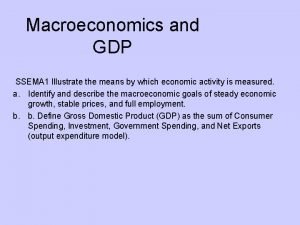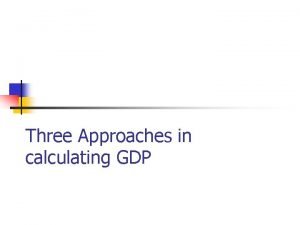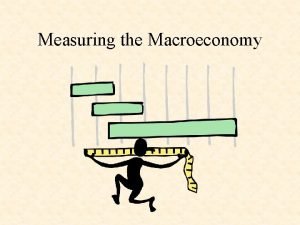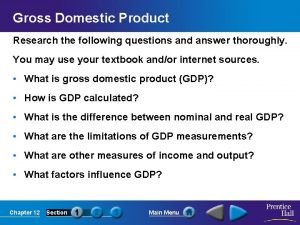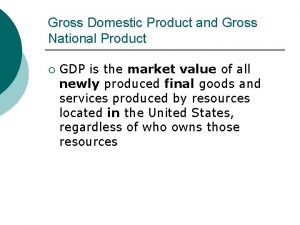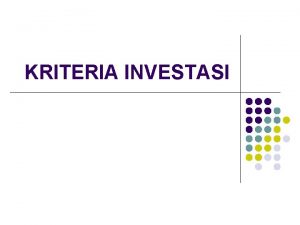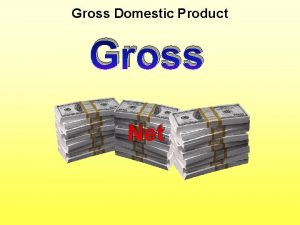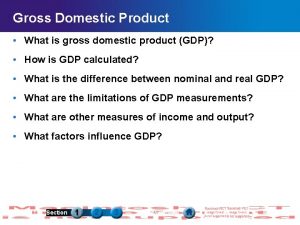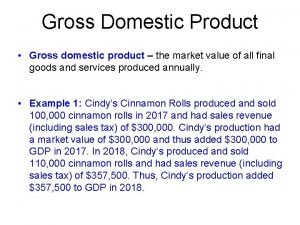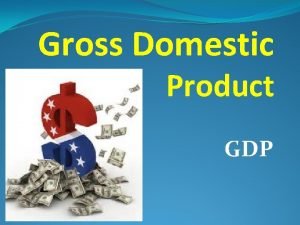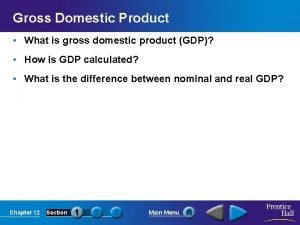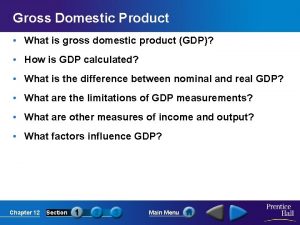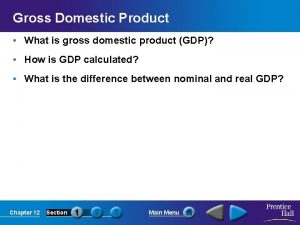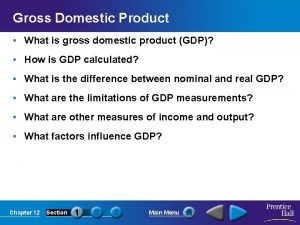Gross Domestic Product Growth Macroeconomics Part 1 Gross













- Slides: 13

Gross Domestic Product & Growth Macroeconomics – Part 1

Gross Domestic Product is The dollar value of all final goods and services produced within a country’s borders in a given year. Let’s break that down, piece by piece.

Gross Domestic Product is The dollar value of all final goods and services produced within a country’s borders in a given year. To get Dollar value we look at the total of the selling prices We don’t look at what they were “worth”

Gross Domestic Product is The dollar value of all final goods and services produced within a country’s borders in a given year. Final goods and services means products sold to consumers It does not mean intermediate goods

Gross Domestic Product is The dollar value of all final goods and services produced within a country’s borders in a given year. The goods must have been made in the country’s border by anybody So, a Toyota plant in the USA counts A Chevrolet plant in Japan does not.

Calculating GDP – Two Methods The Expenditure Approach: counting up the total amount spent on all goods and services. 2. The Income Approach: Add up all income earned in the economy 1. In method 1, we are adding up all the goods and services purchased. In method 2 we are looking at incomes that were used to buy the things in method 1. Thus, they should come out the same.

Nominal vs Real GDP n Nominal GDP is a GDP measured in current prices Thus if a country produced $4, 000 worth of goods last year, it’s nominal GDP is $4, 000) n Real GDP is a GDP measured by a fixed or constant price. n Because prices might have risen and because we are measuring Product (or items produced) and not their price, we have to adjust for those price changes.

Supply and Demand Revisited Price Level: An average of all the goods and services made in one year. 2. Aggregate Demand: the Demand for all goods and services in the Country’s economy 3. Aggregate Supply: the Supply of all goods and services in the Country 4. Aggregate Supply/Aggregate Demand Equilibrium: the Equilibrium price for a Country’s economy 1.

Business Cycles 1. A period of macroeconomic expansion followed by a period of contraction. 2. Has Four Stages: Expansion, Peak, Contraction and Trough

Business Cycle (Continued) 3. Three more terms: A. Recession: a period in which GDP falls for at least 2 consecutive quarters (minimum 6 months) B. Depression: a long and severe recession C. Stagflation (Stagnant + Inflation): a decline in Real GDP and a rise in the price level

Economic Growth n A steady, long-term increase in a nation’s real GDP that tends to raise living standards. n Primary Causes: Capital Deepening: increasing the amount of capital per worker n Saving and Investing n Advances in Technology n

Measuring Economic Growth n Take Real GDP from the later Year (GDP 2) n Subtract Real GDP from the earlier Year (GDP 1) from it n Divide by Real GDP 1 n Multiply by 100 n ((GDP 2 – GDP 1) ÷ GDP 1) x 100

Measuring Economic Growth n So if the Real GDP in 1994 was $7. 8 billion n And Real GDP in 2004 was $10. 8 billion n What was the economic growth? n ((10. 8 – 7. 8) ÷ 7. 8) x 100 = n (3 ÷ 7. 8) x 100 = n. 384 x 100 = n 38. 4%
 Whats included in gdp
Whats included in gdp Calculate gdp at market price
Calculate gdp at market price Formula of gdp
Formula of gdp Gross domestic product in a closed economy consists of
Gross domestic product in a closed economy consists of Gdp 519
Gdp 519 Net exports formula
Net exports formula Net present value adalah
Net present value adalah Plant growth definition
Plant growth definition Monocots eudicots
Monocots eudicots Growthchain
Growthchain Primary growth and secondary growth in plants
Primary growth and secondary growth in plants Chapter 35 plant structure growth and development
Chapter 35 plant structure growth and development Geometric growth graph
Geometric growth graph Neoclassical growth theory vs. endogenous growth theory
Neoclassical growth theory vs. endogenous growth theory
